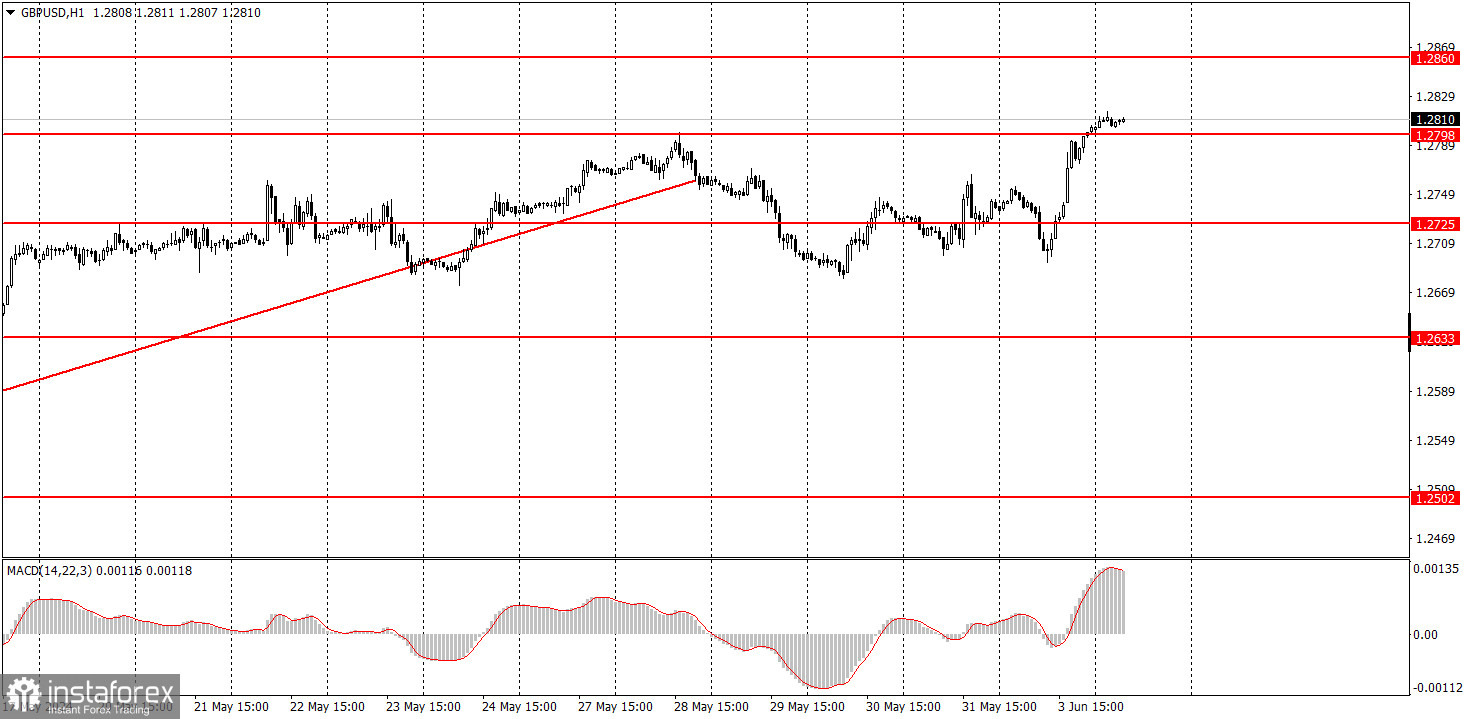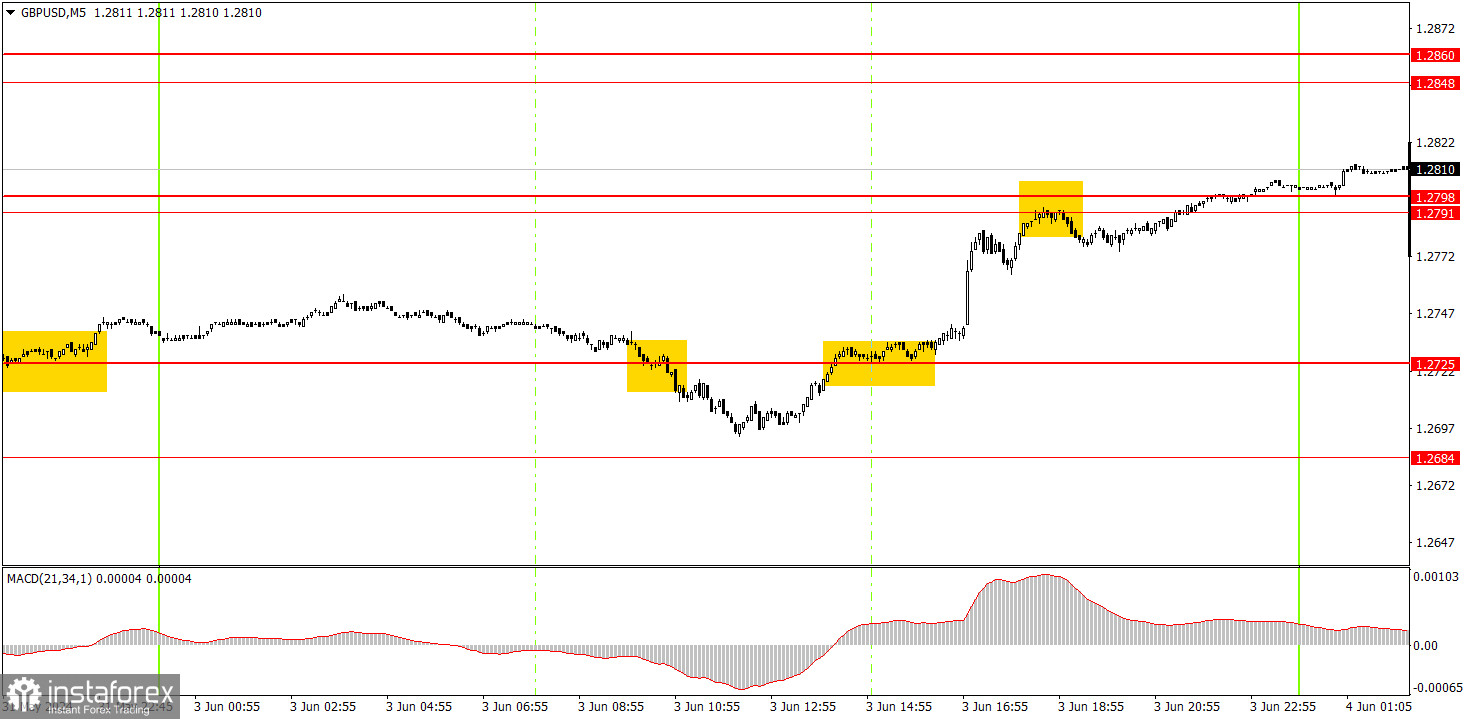Analyzing Monday's trades:
GBP/USD on 1H chart

Yesterday, GBP/USD didn't take too long to decide on its course of action. In the first half of the day, the market made a formal attempt to correct slightly lower, but in the second half of the day, the dollar sharply retreated due to a soft US ISM Manufacturing report. In general, this index was the only cause of celebration on Monday. We warned you that this is an important report, and a weaker value will definitely trigger the dollar's decline, which depreciates against the pound even when there is no apparent reason for it. Therefore, we weren't surprised that the dollar fell by 100 pips. If the rest of this week's US reports also show mediocre or weak values, then there is no doubt that the dollar will continue to fall.
GBP/USD on 5M chart

Three signals were formed on Monday. Initially, the pair consolidated below the level of 1.2735 but only managed to drop 15 pips. Then it consolidated above this level and rose to the range of 1.2791-1.2798, where traders could take profit from a long position. By nightfall, the price already surpassed this range, so today you could even stay in longs. The pound tends to rise anyway...
Trading tips on Tuesday:
On the hourly chart, the GBP/USD pair has great prospects for forming a downward trend, but the bullish correction remains intact. We're not particularly concerned about yesterday's movements, even though it seemed strange for the dollar to suddenly collapse on a single report. However, we'd like to remind novice traders that the dollar doesn't fall solely when there are macroeconomic reasons. If there is no news at all, the pair simply stands still.
The British pound could rise on Tuesday, as the US ISM report set the tone for this week's trading. Today's trading signals can be found around the range of 1.2791-1.2798.
The key levels on the 5M chart are 1.2457, 1.2502, 1.2541-1.2547, 1.2605-1.2633, 1.2684, 1.2725, 1.2791-1.2798, 1.2848-1.2860, 1.2913, 1.2980. On Tuesday, there are no significant events planned in the UK, so in the first half of the day, the pair may exhibit flat movement or gradually edge higher. In the second half of the day, the pair's movements will depend on the nature of the US JOLTs report.
Basic trading rules:
1) Signal strength is determined by the time taken for its formation (either a bounce or level breach). A shorter formation time indicates a stronger signal.
2) If two or more trades around a certain level are initiated based on false signals, subsequent signals from that level should be disregarded.
3) In a flat market, any currency pair can produce multiple false signals or none at all. In any case, the flat trend is not the best condition for trading.
4) Trading activities are confined between the onset of the European session and mid-way through the U.S. session, after which all open trades should be manually closed.
5) On the 30-minute timeframe, trades based on MACD signals are only advisable amidst substantial volatility and an established trend, confirmed either by a trendline or trend channel.
6) If two levels lie closely together (ranging from 5 to 15 pips apart), they should be considered as a support or resistance zone.
How to read charts:
Support and Resistance price levels can serve as targets when buying or selling. You can place Take Profit levels near them.
Red lines represent channels or trend lines, depicting the current market trend and indicating the preferable trading direction.
The MACD(14,22,3) indicator, encompassing both the histogram and signal line, acts as an auxiliary tool and can also be used as a signal source.
Significant speeches and reports (always noted in the news calendar) can profoundly influence the price dynamics. Hence, trading during their release calls for heightened caution. It may be reasonable to exit the market to prevent abrupt price reversals against the prevailing trend.
Beginners should always remember that not every trade will yield profit. Establishing a clear strategy coupled with sound money management is the cornerstone of sustained trading success.
 English
English 
 Русский
Русский Bahasa Indonesia
Bahasa Indonesia Bahasa Malay
Bahasa Malay ไทย
ไทย Español
Español Deutsch
Deutsch Български
Български Français
Français Tiếng Việt
Tiếng Việt 中文
中文 বাংলা
বাংলা हिन्दी
हिन्दी Čeština
Čeština Українська
Українська Română
Română

